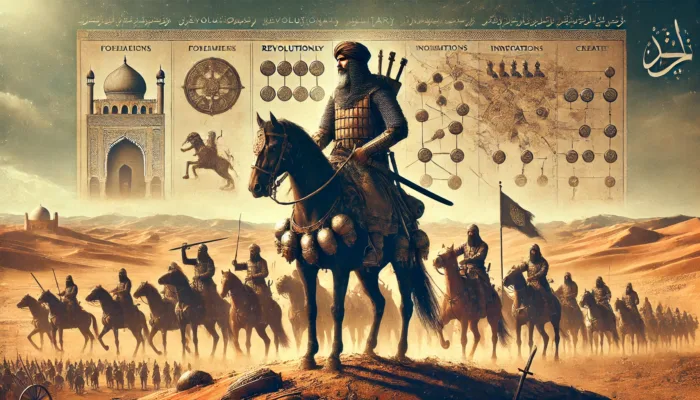Table of Contents
Introduction
The eleventh article in the series the “Era of the Rightly Guided Caliphs“ explores the military innovations and strategies employed by the Muslim conquerors during their battles. This includes their approach to countering the Persian elephants, crossing the Samawah Desert, and engaging in naval warfare. The article also encourages contemporary Muslims to embrace scientific innovation as a means of closing the gap with their adversaries. Click here to explore the full series.
Military Innovations in Islamic Conquests: Shaping the Destiny of Nations
Our ancestors, through their remarkable conquests, achieved something truly extraordinary. The rapid, powerful, and lasting expansion of Islam across the east and west is a testament to their success. Yet today, we will focus on an aspect often overlooked in the history of Islamic conquests: the innovations, inventions, and creative solutions developed by Muslim conquerors. These breakthroughs played a crucial role in determining the outcome of battles and shaping the fate of entire nations.
Battles and wars often mark the beginning and, in some cases, the end of a nation’s story. Every civilization, every state, has its origins in a struggle—be it for liberation, establishment, or independence. Similarly, it is often through conflict that nations meet their downfall and dissolution. A single battle can be pivotal in shaping the destiny of a people, and when these battles feature unexpected innovations and strategies, they can dramatically alter the course of history.
First Strategy: Overcoming the Persian War Elephants with Specialized Units
The first major challenge faced by our conquering ancestors was the formidable Persian war elephants. The Persians utilized elephants in battle, mounting fighters on howdahs strapped to their sides. In ancient times, people were only familiar with the animals in their immediate surroundings—there were no television, internet, or wildlife programs.
When the Muslim cavalry first encountered these massive creatures, the horses were terrified and panicked, often retreating in fear. At that time, cavalry was the backbone of any army, as armies were typically divided into infantry and cavalry. When the Persians brought elephants into the fray, the Muslim horses’ flight created chaos and disrupted the Muslim ranks. This posed a significant challenge, especially during the Battle of Al-Qadisiyyah, a pivotal moment in the Islamic conquests on the Persian front.
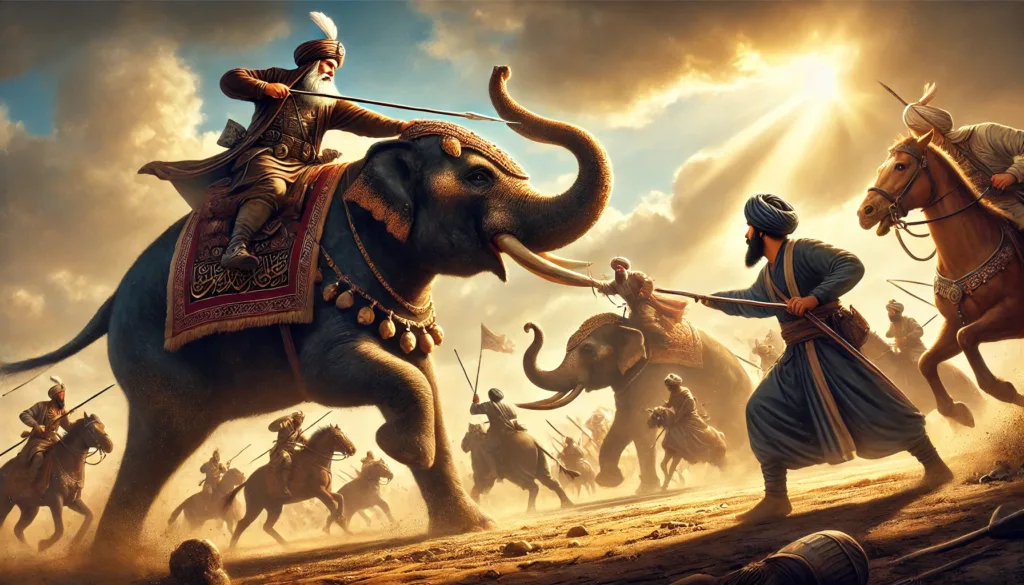
In response, the Muslims applied their ingenuity and devised four strategies to counter the elephants. The first solution involved organizing specialized units to execute a focused attack. The Persian elephants carried howdahs on their flanks, which housed fighters armed with spears. The massive elephants, charging into the Muslim army, caused panic among the horses, which retreated in disarray. The mounted fighters on the elephants would then take advantage of this chaos, stabbing the Muslims with their spears, while Persian infantry followed up to exploit the disruption.
To counter this, the Muslims developed a tactic to neutralize the elephants’ advantage. Some of the Companions and their followers would target the elephants from the flanks and rear, aiming to cut the straps that secured the howdahs to the elephants’ sides. When successful, this strategy would cause the howdahs to collapse, disorienting the Persian fighters atop the elephants. This disruption created confusion within the Persian ranks, and the loss of their mounted fighters threw the elephants into disarray.
This tactic had a significant impact on the Battle of Al-Qadisiyyah. After executing the attack on the first day of battle, the elephants were absent on the second day, as the Persians spent the time repairing and re-securing the howdahs. The elephants returned on the third day, but by then, the Muslims had gained a crucial advantage. The Persians reinforced their elephant units with additional troops, but the focus of the fighters atop the elephants shifted from offensive maneuvers to defensive ones, as they now had to protect themselves from the Muslim attack.
The shift in the Persian forces’ approach, coupled with the added protection around the elephants, led to a change in the behavior of the elephants themselves. When the elephants were surrounded by fewer troops, they were more aggressive and posed a greater threat to the Muslims. However, as the number of protective forces around the elephants increased, it created confusion in the Persian battle strategy. This shift, in turn, resulted in the elephants becoming less aggressive and more subdued, as the added protection disrupted the elephants’ initial fighting power and tactics.
Second and Third Strategy: Creative Solutions and Camouflage to Face the Elephants
This was the first innovation in countering the elephants—the specialized attack carried out by dedicated units. The second innovation came from a Muslim whose name remains unknown, but it suffices that ALLAH knows him. Observing that the Muslim horses were fleeing from the elephants, this man spent the entire night crafting a model of an elephant out of clay in his tent. He then introduced his horse to the clay elephant, ensuring the horse would become accustomed to its presence. The next day, when the horse confronted real elephants on the battlefield, it did not retreat, as it had become familiar with the sight of the clay model.
This innovation allowed Muslim horses to grow more confident and fearless, enabling them to face the elephants without fear. It created a kind of balance between the Muslim cavalry and the Persian elephants, tipping the scales in favor of the Muslims’ primary weapon—horseback.
The third method was another innovation from the great conqueror Al-Qa’qa ibn Amr Al-Tamimi. Al-Qa’qa devised a creative solution by designing a covering for camels, essentially creating a frame to drape over the camels that made them appear as a completely different creature. When this “new creature” entered the battlefield, the Persian horses, remembering the fear they had felt from the elephants, panicked and fled. This tactic, like the previous ones, helped to restore balance between the forces of the Muslims and the Persians.
Fourth Strategy: Intelligence and Precision in Targeting the Elephant Leaders
The fourth method was introduced by the Islamic military intelligence—if we may use that term—through meticulous research and inquiry. They sought knowledge from Bedouins living near Persian territories and from Persians who had embraced Islam. Their investigations revealed crucial details about the elephants: their vulnerable points were the eyes and eyelids, and they were highly dependent on their leaders for guidance.
The intelligence also identified that the thirty elephants used by the Persians in battle were led by two prominent elephants—one white and the other gray or mangy. This vital information was relayed to Sa’d ibn Abi Waqqas (may ALLAH be pleased with him), the commander of the Battle of Al-Qadisiyyah. He entrusted Banu Tamim, under the leadership of Al-Qa’qa ibn Amr Al-Tamimi and Asim ibn Amr Al-Tamimi (may ALLAH be pleased with them), to neutralize the white elephant, which led fifteen others. Meanwhile, Al-Ribeel ibn Amr, leading the infantry from Banu Asad, was tasked with targeting the mangy elephant.
Acting on this intelligence, Al-Qa’qa and Asim launched a coordinated attack on the white elephant. They struck simultaneously with their spears, aiming for its eyes. As the elephant raised its trunk in agony, Al-Qa’qa charged forward with his sword, delivering a decisive blow. The wounded elephant fell and began moving erratically across the battlefield. When it stumbled toward the Muslim ranks, they prodded it with spears, and when it turned toward the Persians, they did the same, causing chaos on both sides.
The second elephant was handled by the special unit from Banu Asad. They managed to strike it in one eye, rendering it half-blind. Interestingly, this one-eyed elephant proved more effective in disrupting the Persian ranks than the completely blind one. Its partial vision led it to flee toward its own forces in panic, trampling Persian soldiers and breaking through their lines. The elephants following it mirrored its chaotic movements, adding to the disorder within the Persian army.
These four innovative tactics collectively ensured a Muslim victory in the Battle of Al-Qadisiyyah. This pivotal battle marked a decisive moment in the Persian front of the Islamic conquests and was one of three key battles that ultimately led to the defeat of the Persian Empire.
Mastering the Desert: Khalid ibn Al-Walid’s Ingenious Crossing of the Samawah Desert
The second innovation came from the great commander Khalid ibn Al-Walid (may ALLAH be pleased with him). While leading the Muslims in their conquest of Persian lands over a period of fourteen months, Khalid achieved remarkable success, purging all the territory south and west of the Euphrates from Persian rule. At the same time, on the Roman front, five Islamic armies had yet to engage in a decisive battle.
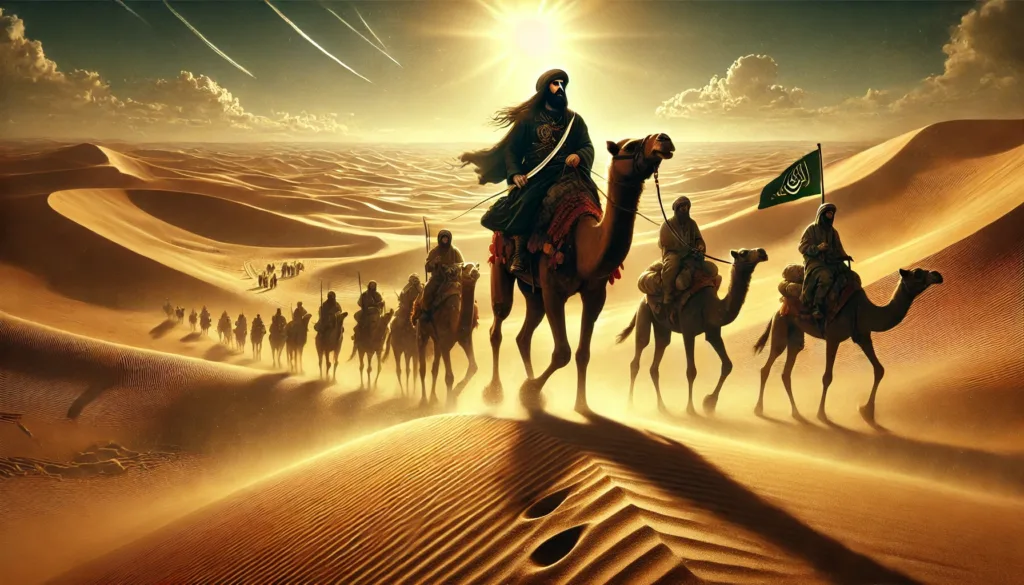
In response, Abu Bakr Al-Siddiq (may ALLAH be pleased with him) decided to recall Khalid ibn Al-Walid and half of his army from the Persian front to support the Levant front—the Byzantine conquest campaign. Khalid sought to reach a strategic location deep within Byzantine territory, but the challenge lay in the lack of a direct route. The southern route through Iraq to the Levant was too time-consuming, and the northern route passed through perilous areas, some still controlled by Bedouins or unconquered Persian forces.
Therefore, Khalid ibn Al-Walid chose the risky option of crossing the Samawah Desert, which separates Iraq from the Levant. This posed a significant challenge: the journey required five days of travel without food or water—an extraordinarily dangerous proposition for an army of nine thousand men.
To overcome this challenge, Khalid’s army demonstrated ingenuity and devised an innovative solution. They made a number of camels thirsty for several days, then provided them with water. The camels drank heavily, storing the water in their humps. To prevent them from consuming the water in their bellies, they tied the camels’ mouths shut, ensuring they wouldn’t ruminate.
During their march, when food and water became scarce, they slaughtered the camels, taking the stored water from their humps and using it to hydrate the soldiers. Additionally, they mixed the camels’ milk with water and consumed their meat, providing several food sources for the army.
Through this innovative approach, the Muslim army achieved a historic crossing—an unprecedented feat—across the Samawah Desert. In just five days, the army reached Syria, without losing a single man. This remarkable achievement became one of the many innovations associated with Khalid ibn al-Walid (may ALLAH be pleased with him) and is recorded in history as a testament to his leadership and ingenuity.
Naval Warfare Innovation: The Birth of the Muslim Fleet and the Battle of Dhat Al-Sawari
The third innovation we explore took place during the Battle of Dhat Al-Sawari, the first naval confrontation between the Muslims and the Byzantines. By this time, after two decades of conquests, the Muslims had successfully taken control of the Levant, expelled the Roman Empire from the region, and secured Egypt, thus gaining control of vital ports.
Up until this point, all engagements between the Muslims and the Byzantines had been on land, with no naval battles. The Byzantine Roman fleet was well-established, dominating the Mediterranean coast and its eastern shores, as the Roman Empire controlled territories to the north, south, and east of the Mediterranean.
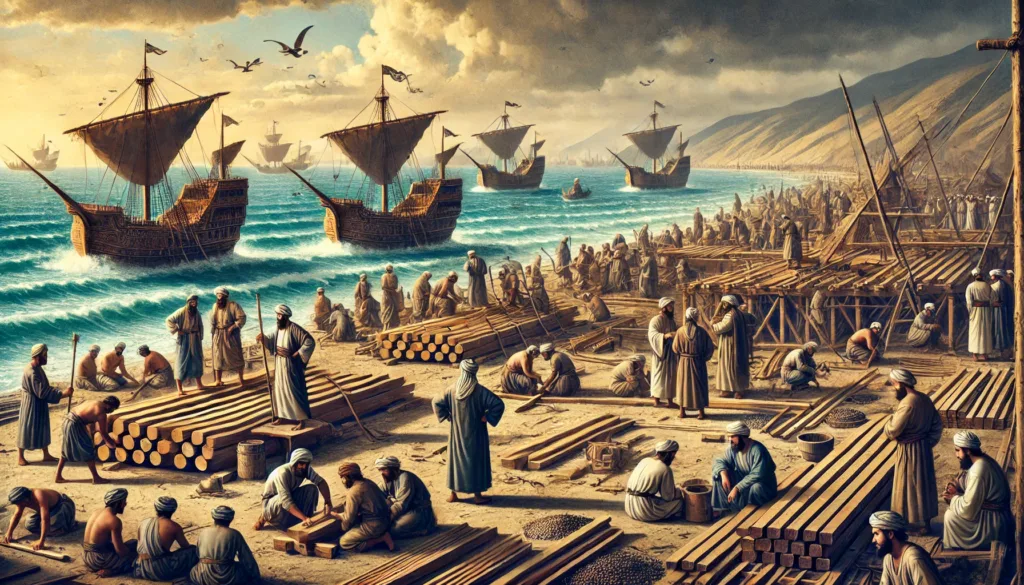
During the era of Umar ibn Al-Khattab (may ALLAH be pleased with him), Muawiyah ibn Abi Sufyan (may ALLAH be pleased with him) had persistently requested permission to build a fleet and wage naval warfare. However, Umar, concerned about the safety of the Muslims—since the Arabs were not experienced seafarers—refused to grant him permission to build a fleet or engage in naval Jihad.
Following Umar’s death, the situation changed. The Byzantine fleet launched an attack on the city of Tripoli in the Levant. While the Muslims successfully repelled the attack, it became clear that Muawiyah’s assessment had been correct: the Muslims needed a naval force to challenge the powerful Byzantine fleet.
Muawiyah once again sought permission, this time from the Caliph Uthman ibn Affan (may ALLAH be pleased with him), who agreed to allow the construction of a fleet and the initiation of naval Jihad under two conditions: first, that only volunteers would be enlisted, and second, that Muawiyah and his family would be the first to participate in this venture to ensure no undue risk to the broader Muslim community.
Revolutionizing Naval Combat: The Strategic Brilliance Behind the Battle of Dhat Al-Sawari
Muawiyah ibn Abi Sufyan’s establishment of the Islamic fleet marked a turning point in the Muslim conquests, particularly in confronting the Byzantine Empire. By 34 AH, roughly two decades after the beginning of the Islamic conquests, the Muslims were ready to engage the Byzantines in naval warfare. This led to the historic Battle of Dhat Al-Sawari, where two hundred Islamic ships faced off against eight hundred Byzantine ships.
The Byzantine forces were led by Emperor Constans II, the son of the famous Byzantine emperor Heraclius. The battle took place near the coast of Antalya, in modern-day Turkey, in a region characterized by bays and islands. This geographical setup made it particularly challenging for the Byzantine fleet to encircle the Muslim forces and create a blockade.
The clash between the two fleets was not just a battle of arms, but also a clash of strategies. The Byzantines, with their long-standing naval supremacy, sought to leverage their advantage in the sea, while the Arabs, with their deep expertise in land warfare, were at a disadvantage on the water. However, under the leadership of Abdullah ibn Sa’d ibn Abi Al-Sarh (may ALLAH be pleased with him), the Muslims came up with a game-changing strategy that altered the course of naval warfare.
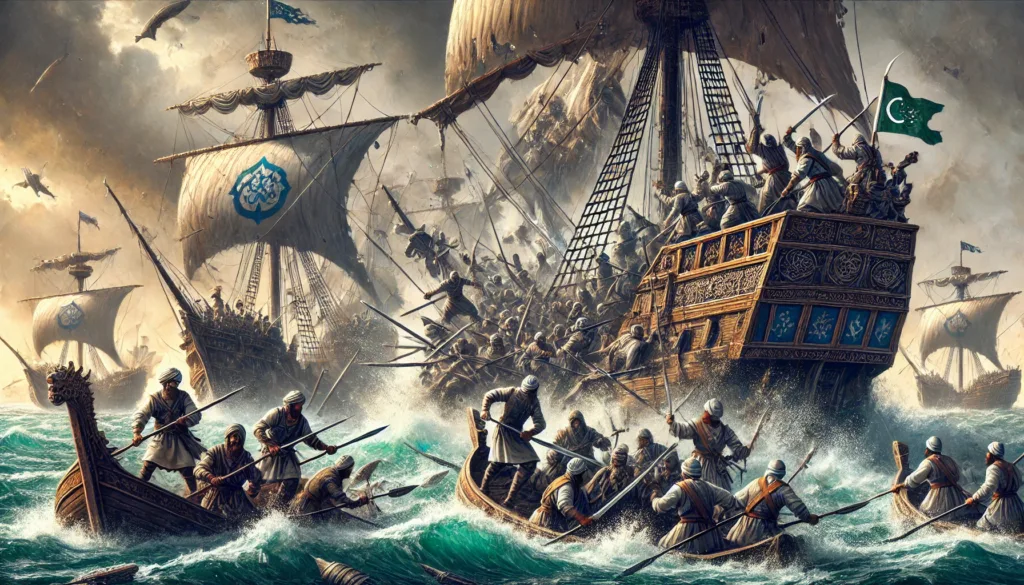
The innovation devised by the Muslim commanders involved a daring tactic to counter the Byzantine fleet’s superior numbers and mobility. Special units, working in the waters beneath the ships, would bind the Islamic ships to each other using ropes. This tactic had two key benefits: first, it prevented the Byzantine ships from breaking through the lines of the Muslim ships and implementing a blockade; second, it allowed the Muslim fleet to maneuver more effectively, despite the challenge of the open sea.
But the strategy didn’t stop there. The Muslims also sought to bind as many Byzantine ships as possible to the Islamic fleet. This turned the battle into something akin to a land battle. The ships, now tethered together, had limited movement, and the Byzantines were forced to fight on terrain that played to the Muslims’ strengths — the close quarters of a land battle.
A fierce battle ensued, with the Muslims ultimately emerging victorious. The victory was significant not just in terms of the number of Byzantine casualties but also because the Byzantine Emperor Constans II himself was wounded during the engagement. The Byzantine fleet, once a symbol of Mediterranean dominance, was decisively broken, and its control over the Mediterranean shores came to an end.
The aftermath of the Battle of Dhat Al-Sawari marked the rise of Islamic naval power. The Muslims, now in control of the seas, could secure their coasts and cities from Byzantine naval attacks, ensuring greater stability and expansion across the Mediterranean region.
The Call for Innovation: Bridging the Scientific Gap and Empowering Future Victories
The night of our nation has indeed grown long, and the distance between us and our enemies has only widened, particularly in the realm of science and technology. This growing gap is not only a reflection of our enemies’ advancements but also a direct result of the oppressive regimes that have stifled our intellectual and scientific potential.
These regimes have created an environment where creativity, innovation, and critical thinking are either suppressed or used for purposes that serve the status quo, rather than addressing the real needs of our people. Ideas and inventions that could elevate the nation and bridge this gap are either feared or discouraged, for those in power cannot be trusted to use them for the collective good.
Take, for example, the issue of aircraft. No matter how courageous the soldiers on the ground are, they cannot escape the bombs, gases, and explosive barrels that are dropped upon them. Similarly, reconnaissance aircraft continue to transmit valuable information. These challenges remain unsolved and require the ingenuity and innovation of our nation’s minds to find solutions, which will ultimately narrow the scientific gap and bring us closer to victory.
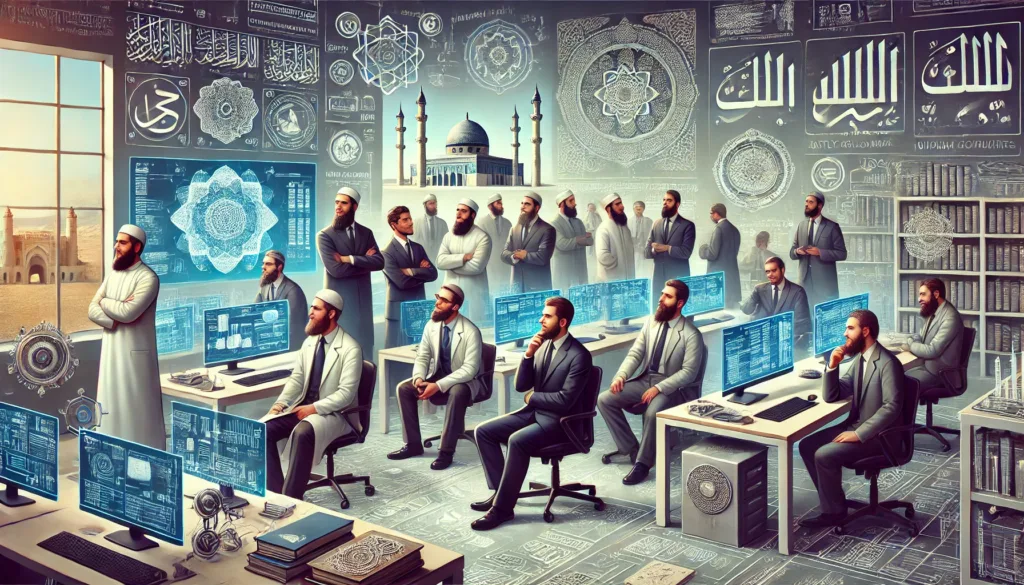
This is a matter that requires the participation of everyone, even those with valid excuses. We are entering a long phase of gathering information, analyzing it, and patiently developing the ideas needed to address the vast scientific disparity between us and our enemies. Those who are able to work from the safety of their homes, offices, or secure locations have an important role to play as well. Their contributions are crucial in providing ideas and insights that can support those on the front lines, aiding the warriors in the way of ALLAH.
For engineers, chemists, and programmers, it is a personal obligation to contribute their knowledge and skills as a form of charity for the benefit of the nation. By applying their expertise, they can help close the significant gap between us and our enemies. A single invention, no matter how small, could turn the tide of a battle and leave its inventor’s name etched alongside the great conquerors: Khalid ibn Al-Walid, Al-Qa’qa ibn Amr Al-Tamimi, Abdullah ibn Sa’d ibn Abi Al-Sarh, and others.
Conclusion
We ask ALLAH, the Blessed and Exalted, to teach us what benefits us, to benefit us with what HE has taught us, and to increase us in knowledge.
Sources:
- Mohamed Elhamy. محمد إلهامي | عصر الخلافة الراشدة | 11. ابتكارات واجتهادات فارقة. YouTube Video.

